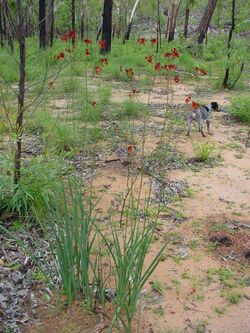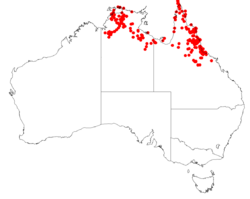Biology:Haemodorum coccineum
| Haemodorum coccineum | |
|---|---|

| |
| Scientific classification | |
| Kingdom: | Plantae |
| Clade: | Tracheophytes |
| Clade: | Angiosperms |
| Clade: | Monocots |
| Clade: | Commelinids |
| Order: | Commelinales |
| Family: | Haemodoraceae |
| Genus: | Haemodorum |
| Species: | H. coccineum
|
| Binomial name | |
| Haemodorum coccineum | |

| |
| H. coccineum collection data from Australasian Virtual Herbarium | |
Haemodorum coccineum (bunyagutjagutja,[1] bloodroot,[2] menang,[3] scarlet bloodroot,[4] red root[5]) is a flowering plant in the same family as kangaroo paw.
Description
A perennial herb[6] to one meter high.[5][6] Although it is not grass, it has a grass-like appearance, with strap-like,[2][5] narrow, leathery leaves arising from the base of the plant.[2][6]
Flowering usually occurs between November and March, during the Top End wet season, however flowers have been observed as early as October and as late as May.[6] The flowers are deep-red or orange red and occur in dense clusters on long stiff stalks,[2][6] which also arise from the base of the plant.[6]
Fruit develop between November and March, and can linger until May.[6] The fruit are red[5][6] to black,[2] fleshy capsules with three lobes.[6] The mature fruit release a red-purple juice when crushed.[6]
Distribution and habitat
Found in the Top End of the Northern Territory,[2][6][7] Northern Queensland[2][6][7] and Papua New Guinea.[7] Occurs in open woodland habitats on gravelly or shallow lateritic soils and sandstone.[6]
Uses
Dyes
Indigenous Australians use this plant to make red, brown and purple dyes for coloring plant fibres.[1][2][6][8]
The bulbous red root is chopped or crushed and boiled in water to release the red-brown dyes, while the purple shades are made from H. coccineum fruit.[8]
Fibres such as the stripped leaves of Pandanus spiralis or the new leaves of Livistona humilis are added to the dye-bath, and later the colored fibre is used to make items such as baskets (Pandanus), string bags (Livistona) and fibre sculptures.[8]
Other uses
Suitable as a bedding or edging plant in native gardens.[5]
The fruits can be used in floral arrangements.[2]
Some sources report Indigenous Australians used the plant to treat snake-bite, and the dry stalks were used as fire-sticks.[6]
Propagation and cultivation
Haemodorum coccineum can be propagated from seed.[2] Vegetative propagation can be achieved by dividing the bulbous root.
Plants prefer a well-drained sandy or gravelly soil and full sun.[2] In the dry season the plant will usually die back,[2] leaving the underground rootstock to regenerate later in the year.
References
- ↑ 1.0 1.1 Bula’bula Arts Aboriginal Corporation (2013) at http://www.bulabula-arts.com/Site/our-art/aboriginal-fibre-art.html. Accessed 2 September 2013
- ↑ 2.00 2.01 2.02 2.03 2.04 2.05 2.06 2.07 2.08 2.09 2.10 2.11 Wrigley, J.W. and Fagg, M. 2007 Australian Native Plants, Reed New Holland, Sydney, Australia
- ↑ "Bloodroot - Haemodorum spicatum" (in en-US). https://tuckerbush.com.au/bloodroot-haemodorum-spicatum/.
- ↑ Atlas of Living Australia website at http://bie.ala.org.au/search?q=haemodorum+coccineum. Accessed 2 September 2013
- ↑ 5.0 5.1 5.2 5.3 5.4 Smith, N., 2007, Native Plants for Top End Gardens, Greening Australia (NT) Ltd, Darwin, Australia
- ↑ 6.00 6.01 6.02 6.03 6.04 6.05 6.06 6.07 6.08 6.09 6.10 6.11 6.12 6.13 6.14 Brock, J., 1988 Top End Native Plants, John Brock, Darwin, Australia
- ↑ 7.0 7.1 7.2 The Council of Heads of Australasian Herbaria (2013) Australia’s Virtual Herbarium. http://avh.ala.org.au/occurrences/search?taxa=Haemodorum+coccineum#tab_mapView [Accessed 2 September 2013]
- ↑ 8.0 8.1 8.2 Artback Northern Territory Arts Touring (2007) Recoil Education Kit at http://www.artbacknt.com.au/images/arts/recoil/pdf/teachersnotes.pdf. Accessed 2 September 2013
External links
Wikidata ☰ Q5638244 entry
 |

